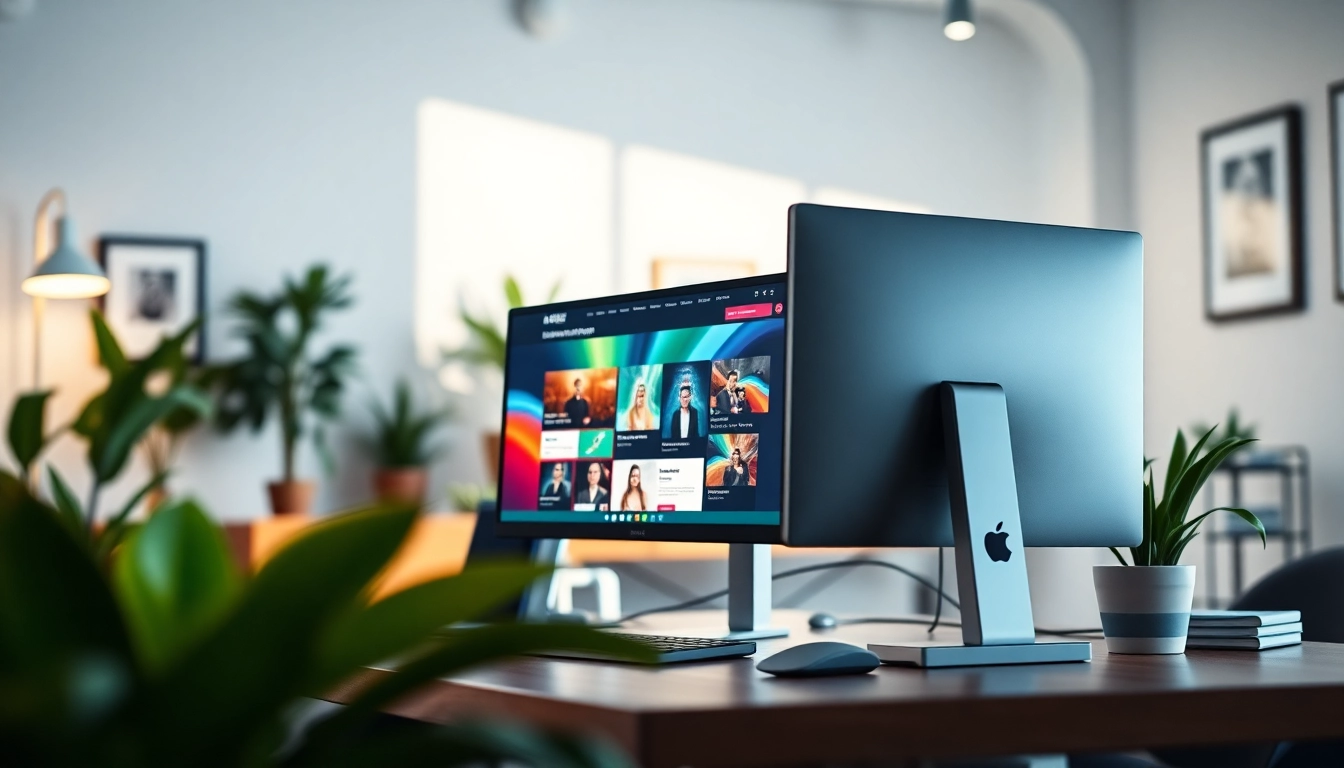Understanding the Basics of Website Design
In today’s digital landscape, crafting an engaging and functional online presence is vital for businesses and individuals alike. This necessity has ushered in the prominence of website design as a discipline that combines aesthetics with usability. By understanding how website design impacts user interaction and brand image, you can enhance your online visibility and success.
What is website design?
Website design refers to the process involving the creation of websites and web applications that deliver an optimal experience to users. It encompasses various aspects, including layout, color schemes, typography, images, and overall user interface (UI) and user experience (UX) design. The goal of website design is not just to make a site look appealing but to ensure it functions well across all devices and meets the needs of its users.
Key elements of effective website design
To create a website that captivates visitors and meets their needs, several key elements need careful consideration:
- Layout: This refers to the arrangement of visual elements on a page. It should be intuitive so that users can navigate easily.
- Color Scheme: Colors influence perceptions and emotions, making it crucial to choose a palette that resonates with your brand identity.
- Typography: The fonts you choose can either enhance or detract from readability and the overall aesthetic of your site.
- Images and Graphics: High-quality visuals engage users and can effectively convey your brand message when aligned with the site’s purpose.
- User Interface (UI): This aspect focuses on the design of on-screen elements like buttons and navigation menus, ensuring they are user-friendly and accessible.
- User Experience (UX): This broader concept encompasses all user interactions with your site, ensuring they find the site easy to use and valuable to visit.
The importance of user experience in website design
User experience is essential in web design because it dictates how users interact with your site. A positive UX can lead to higher conversion rates, increased user engagement, and improved brand loyalty. When designing a website, consider factors such as load time, mobile responsiveness, and intuitive navigation. Each of these elements contributes to how users perceive your site and whether they will return in the future.
Choosing the Right Tools for Website Design
Popular software for website design
Choosing the right tools can significantly streamline the website design process. Numerous software options are available that cater to different skill levels, from beginners to advanced designers. Here are some popular tools:
- Adobe XD: Excellent for UX/UI design, allowing designers to create wireframes and prototypes seamlessly.
- Figma: A robust collaborative design tool for modern web and app design with real-time feedback and changes.
- Sketch: A vector-based design tool popular among web designers for its simplicity and powerful features.
- Canva: An accessible tool enabling users to create visually appealing graphics for their websites and social media.
- WordPress: A content management system that not only allows for blogging but also provides robust website design options using themes and plugins.
Comparing design frameworks for website design
Frameworks can simplify the web design process by providing pre-written code, components, and templates. Some popular frameworks include:
- Bootstrap: A leading framework for responsive web design that allows developers to create mobile-first websites quickly.
- Foundation: Similar to Bootstrap, Foundation is a responsive front-end framework that provides custom templates.
- Tailwind CSS: A utility-first CSS framework that promotes creating designs directly in your markup.
Choosing the right framework depends on your project requirements, team experience, and long-term maintenance vision. Evaluating your priorities will help identify the best fit.
Utilizing templates versus custom designs
When initiating a website design project, designers often face the choice between using templates or creating custom designs. Here are the pros and cons of each:
- Templates:
- Advantages: Quick to implement, often cost-effective, and user-friendly for non-designers.
- Disadvantages: Potential issues with uniqueness, alongside limited customization options.
- Custom Designs:
- Advantages: Offers unparalleled uniqueness and functionality tailored specifically to user needs.
- Disadvantages: Typically requires more time and investment, and may necessitate specialized skills.
Ultimately, the choice will depend on individual goals, budgets, and the desired user experience.
Best Practices in Website Design
Creating a mobile-responsive website design
With an increasing number of users accessing websites from mobile devices, a mobile-responsive design is no longer optional. Implementing a responsive design involves creating layouts that adapt to various screen sizes, enhancing usability and performance across devices. Some best practices include:
- Use fluid grids to allow flexible resizing.
- Consider mobile-first design principles, starting the design process with mobile layouts.
- Employ media queries to modify styles based on the device’s characteristics.
Integrating SEO into your website design
Integrating search engine optimization (SEO) practices from the outset is crucial for maximizing a website’s visibility. Important SEO considerations in the design process include:
- Site Structure: Design a logical structure that allows search engines to index pages easily.
- Fast Loading Times: Optimize images and code to ensure quick load times, which is a key factor for SEO rankings.
- Mobile Optimization: As previously discussed, ensure that your website is mobile-friendly, as search engines prioritize mobile-optimized sites in their rankings.
- Alt Text for Images: Use descriptive alt text for images to boost SEO while enhancing accessibility.
Design principles for optimizing user engagement
User engagement can be enhanced significantly through effective design principles, leading to prolonged visits and improved conversion rates. Here are some vital principles to keep in mind:
- Clear Call-to-Actions: Use strategically placed buttons and messages prompting users to take specific actions.
- Consistent Branding: Maintain visual consistency across all pages to solidify brand identity.
- A/B Testing: Experiment with different design elements to discover the most effective combinations for user engagement.
Case Studies in Successful Website Design
Analyzing award-winning website designs
Examining award-winning websites can offer valuable insights into effective design practices. These sites typically excel in the balance of aesthetics and functionality while providing positive user experiences. Key traits of such sites often include:
- Innovative navigation that enhances usability.
- Stunning visual elements that engage users without overwhelming them.
- Strategic use of whitespace that guides the eye and improves readability.
Lessons learned from redesigns
Redesigning a website can yield significant improvements in user engagement and conversion rates. It’s crucial to learn from past mistakes and successes:
- User Feedback: Incorporating user feedback into redesigns can reveal valuable insights into pain points and preferences.
- Analytics Tracking: Measure performance metrics before and after a redesign to judge its effectiveness.
Industry-specific website design examples
Different industries often have varying needs in terms of website design. For example, an e-commerce site requires strong visual elements to showcase products, while a service-based business might prioritize contact information and customer testimonials. Customizing designs to fit the industry’s specific target audience will enhance relevance and user satisfaction.
Future Trends in Website Design
The rise of AI in website design
Artificial intelligence is increasingly shaping website design by automating repetitive tasks and providing personalized user experiences. Innovations such as AI-driven content creation tools and chatbots can enhance customer service and engagement on websites:
- AI tools can analyze user behavior and preferences, informing design modifications.
- Chatbots can provide immediate responses to common inquiries, improving the overall UX.
Emerging technologies impacting website design
As technology evolves, so does the approach to website design. New innovations such as AR and VR are beginning to find their place in web design:
- Augmented Reality (AR): Enables users to visualize products or services in their actual environments before purchasing.
- Virtual Reality (VR): Offers immersive web experiences, which can be particularly engaging in industries like real estate and entertainment.
Staying ahead in the evolving landscape of website design
To remain competitive in the ever-evolving world of website design, professionals must stay current with emerging trends, technologies, and user preferences. Continuous learning, experimenting with new tools, and actively seeking feedback can all contribute to a successful web design strategy. By keeping pace with the industry, you can ensure your designs remain relevant and effective in meeting user needs.























+ There are no comments
Add yours